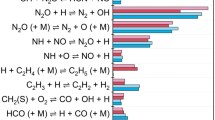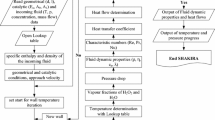Abstract
A propellant is a chemical combination burned to produce thrust in rockets, which consists of an oxidizer and fuel. At present, many space propulsion systems utilize nitrogen tetroxide as the oxidizer and one of the forms of hydrazine as the fuel. Hydrazine is a highly toxic, explosive material and requires supreme safety measures. Scientists are developing environmentally friendly propellant mixtures that are hypergolic and have performance levels near traditional propellants called green propellants. Green propellants are low toxicity and high-energy rocket propellants that will offer a high-performance, elevated efficiency alternative to conventional chemical propellants for future spaceship. Green propellants mitigate the cost and risk associated with the transport and storage, cleanup of accidental releases, and human exposure to traditional propellants. This research deals with the development of lower toxicity reactive propellant combination compared to hydrazine, which is hypergolic and has performance levels near the traditional storable propellants for implementation in small-size spacecraft applications. Analytical reagent grade nitric acid 98% and sodium borohydride 97% in addition to paraffin wax are estimated as substitutes of green propellant for state-of-the-art propellants that are used for space propulsion. The hypergolic ignition viability in two different environments was tested of ignition and was measured for sodium borohydride loading in paraffin wax.












Similar content being viewed by others
Abbreviations
- GPIM :
-
Green Propellant Infusion Mission
- DBFC :
-
Direct borohydride fuel cell
- SEM :
-
Scanning electron microscope
- EDX :
-
Energy-dispersive X-ray spectroscopy
- TGA :
-
Thermogravimetric analysis
- NaBH 4 :
-
Sodium borohydride
- HNO 3 :
-
Nitric acid
- N 2 H 4 :
-
Hydrazine
- CO 2 :
-
Carbon dioxide
- HAN :
-
Hydroxylammonium nitrate
- ADN, NH 4 N(NO 2 ) 2 :
-
Ammonium dinitramide
- HAN, NH 3 OHNO 3 :
-
Hydroxylammonium nitrate
- NTO, N 2 O 2 :
-
Nitrogen tetroxide
- MMH, CH 3 (NH)NH 2 :
-
Monomethyl hydrazine
- C 2 H 4 :
-
Ethylene
- N 2 O :
-
Nitrous oxide
- CH 3 OH :
-
Methanol
- NH 3 :
-
Ammonia
- AlH 3 :
-
Aluminum hydride
- HTPB :
-
Hydroxyl-terminated polybutadiene
- DCPD, C 10 H 12 :
-
Dicyclopentadiene
References
G.P. Sutton, O. Biblarz, Rocket Propulsion Elements JOHN WILEY & SONS (Inc, New York, 2001)
Gruntman, M. (2004). Blazing the trail: the early history of spacecraft and rocketry. American Institute of Aeronautics and Astronautics.
D. Altman, A. Holzman, Overview and history of hybrid rocket propulsion. Progress in Astronautics and Aeronautics 218, 1 (2007)
Force, A. (1993). Occupational Safety and Health (AFOSH) Standard 48-1. Respiratory Protection Program.
World Health Organization. (1991). Hydrazine Health and Safety Guide-Health and Safety Guide 56.
M.C. Mitchell, R.W. Rakoff, T.O. Jobe, D.L. Sanchez, D.B. Wilson, Thermodynamic analysis of equations of state for the monopropellant hydrazine. Journal of thermophysics and heat transfer 21(1), 243–246 (2007)
J.L. Haws, B.G. Harden, Thermodynamic properties of hydrazine. Journal of Spacecraft and Rockets 2(6), 972–974 (1965)
Clark, S (2019). "U.S. military's X-37B spaceplane lands in Florida". Spaceflight Now. Retrieved 28 October 2019.
U.S. AIR FORCE, (2010)"X-37B Orbital Test Vehicle lands at Vandenberg AFB" Dec 03, 2010.
C. McLean, Green Propellant Infusion Mission (GPIM). NASA 2020 (2021)
R. Aggarwal, I. Patel, P.B. Sharma, Green propellant: A study. International Journal of Latest Trends in Engineering and Technology 6(1), 83–87 (2015)
McLean, C. H. (2013). Green propellant infusion mission program overview. In 49th AIAA/ASME/SAE/ASEE Joint PropulsionConference (p. 3847).
Kamata, H., Igarashi, S., Yamamoto, K., & Fukuchi, A. (2019). U.S. Patent Application No. 16/244,222.
D.H. Busch, Inorganic Syntheses, vol 20 (John Wiley & Sons, 2009)
Rittmeyer, P., & Wietelmann, U. (2000). Hydrides. Ullmann's Encyclopedia of Industrial Chemistry.
L. Banfi, E. Narisano, R. Riva, N. Stiasni, M. Hiersemann, T. Yamada, T. Tsubo, Sodium borohydride. Encyclopedia of Reagents for Organic Synthesis, 1–13 (2001)
V. Dalla, J.P. Catteau, P. Pale, Mechanistic rationale for the NaBH4 reduction of α-keto esters. Tetrahedron Letters 40(28), 5193–5196 (1999)
Lide, D. R. (2000). Handbook of Chemistry and Physics, 81st edn., Sect. 11.
Quach, P., Brand, A., & Warmoth, G. (2015). Adiabatic Compression Testing of AF-M315E. In 51st AIAA/SAE/ASEE Joint Propulsion Conference (p. 3752).
A. Larsson, N. Wingborg, Green propellants based on ammonium dinitramide (ADN). Advances in Spacecraft Technologies, 139–156 (2011)
Werling, L., Perakis, N., Müller, S., Hauck, A., Ciezki, H., & Schlechtriem, S. (2016). Hot firing of a N2O/C2H4 premixed green propellant: First combustion tests and results. In Space Propulsion Conference.
Y. Zhang, H. Gao, Y.H. Joo, J.N.M. Shreeve, Ionic liquids as hypergolic fuels. Angewandte Chemie International Edition 50(41), 9554–9562 (2011)
J. Barluenga, M. Trincado, E. Rubio, J.M. González, IPy2BF4-Promoted Intramolecular Addition of Masked and Unmasked Anilines to Alkynes: Direct Assembly of 3-Iodoindole Cores. Angewandte Chemie International Edition 42(21), 2406–2409 (2003)
Spores, R. A. (2015). GPIM AF-M315E propulsion system. In 51st AIAA/SAE/ASEE Joint Propulsion Conference (p. 3753).
Anflo, K., Crowe, B., & Persson, M. (2010). The first in-space demonstration of a green propulsion system.
Persson, M., Anflo, K., Dinardi, A., & Bahu, J. (2012). A family of thrusters for ADN-based monopropellant LMP-103S. In 48th AIAA/ASME/SAE/ASEE Joint Propulsion Conference & Exhibit (p. 3815).
Shark, S. C. (2014). Metal hydride and pyrophoric fuel additives for dicyclopentadiene based hybrid propellants (Doctoral dissertation, Purdue University).
Steiner, M. W. (2015). The development of reactive fuel grains for pyrophoric relight of in-space hybrid rocket thrusters (Doctoral dissertation, Purdue University).
F. Maggi, G. Gariani, L. Galfetti, L.T. DeLuca, Theoretical analysis of hydrides in solid and hybrid rocket propulsion. International Journal of Hydrogen energy 37(2), 1760–1769 (2012)
Haynes, William M., ed. (2011). CRC Handbook of Chemistry and Physics (92nd ed.). CRC Press. p. 4.89. ISBN 978-1439855119.
M.E. Hossain, M.S. Rahman, C. Ketata, H. Mann, M.R. Islam, SEM-based structural and chemical analysis of paraffin wax and beeswax for petroleum applications. Journal of characterization and Development of Novel Materials 1(1), 21–38 (2009)
W.E. Nasser, Waxes, natural and synthetic. Encyclopedia of chemical processing and design 67, 11–18 (1999)
A. Bucio, R. Moreno-Tovar, L. Bucio, J. Espinosa-Dávila, F. Anguebes-Franceschi, Characterization of beeswax, candelilla wax and paraffin wax for coating cheeses. Coatings 11(3), 261 (2021)
Z. Sam, L. Lin, K. Ashok, Materials Characterization Techniques. Taylor & Francis Group Cap 7, 177–205 (2009)
Y. Leng, Materials characterization: introduction to microscopic and spectroscopic methods (John Wiley & Sons, 2009)
D. Stokes, Principles and practice of variable pressure/environmental scanning electron microscopy (VP-ESEM) (John Wiley & Sons, 2008)
J.I. Goldstein, D.E. Newbury, J.R. Michael, N.W. Ritchie, J.H.J. Scott, D.C. Joy, Scanning electron microscopy and X-ray microanalysis (Springer, 2017)
A.W. Coats, J.P. Redfern, Thermogravimetric analysis. A review. Analyst 88(1053), 906–924 (1963)
M. Makhdoom, S. Azam, T.A. Alrebdi, S. Ayaz Khan, A. Iqbal, M.B. Kanoun, S. Goumri-Said, Rb and Cs doping effects in sodium borohydride: Density functional theory for hydrogen (H2) storage purpose. International Journal of Hydrogen Energy 46(2), 2405–2412 (2021)
S. Goumri-Said, R. Ahmed, M.B. Kanoun, Density-functional study of High hydrogen content complex hydrides Mg (BH4)2: a promising conducting hydride. Renewable Energy 90, 114–119 (2016)
B. Ul Haq, M.B. Kanoun, R. Ahmed, M. Bououdina, S. Goumri-Said, Hybrid functional calculations of potential hydrogen storage material: Complex dimagnesium iron hydride. Int J Hydrogen Energy 39(18), 9709–9717 (2014)
K. Veale, S. Adali, J. Pitot, M. Brooks, A review of the performance and structural considerations of paraffin wax hybrid rocket fuels with additives. Acta Astronautica 141, 196–208 (2017)
David A. Castaneda, Benveniste Natan, Experimental investigation of the hydrogen peroxide – solid hydrocarbon hypergolic ignition, Acta Astronautica, Volume 158, May 2019, Pages 286-295.
Author information
Authors and Affiliations
Corresponding author
Ethics declarations
Competing interests
The authors declare no competing interests.
Rights and permissions
About this article
Cite this article
Altuwayjiri, G., Alotaibi, R., Albarqan, M. et al. Exploring low toxic and green propellants based on sodium borohydride. emergent mater. 5, 1227–1239 (2022). https://doi.org/10.1007/s42247-022-00384-w
Received:
Accepted:
Published:
Issue Date:
DOI: https://doi.org/10.1007/s42247-022-00384-w




